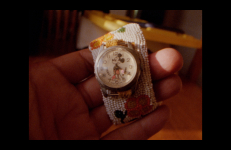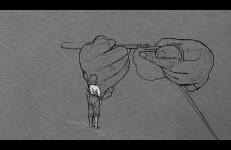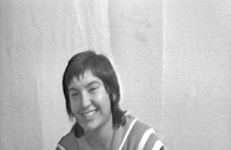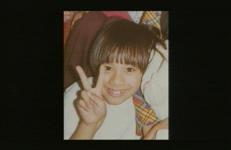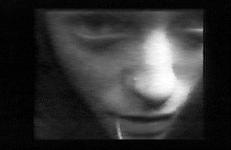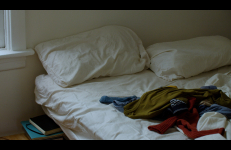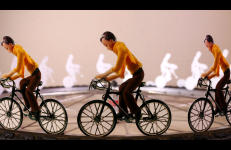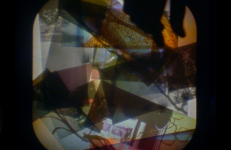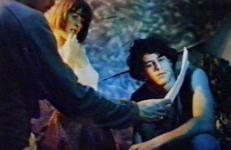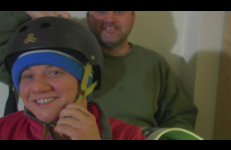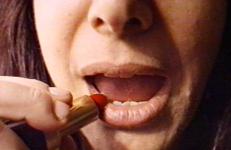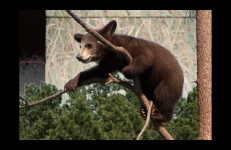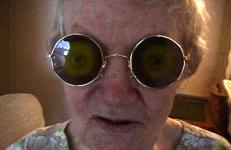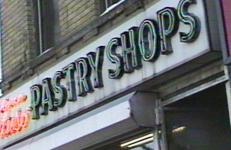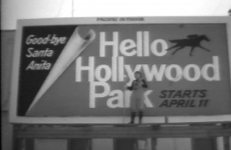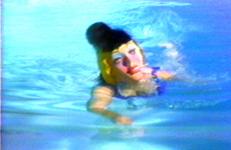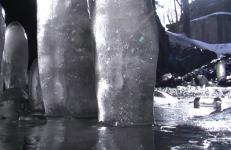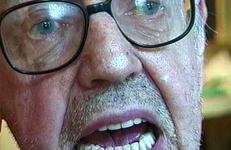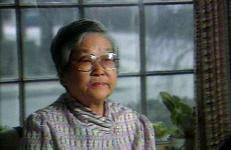This film is a reflection on descendants and ancestors, guided by a 50 year old audio recording of my grandmother learning the Pechanga language from her mother. After being given this tape by my mother, I interviewed her and asked about it, and recorded her ruminations on their lives and her own. The footage is of our chosen home in Whatcom County, Washington, where my family still lives, far from our homelands in Southern California, yet a home nonetheless.
Autobiography
Kiss The Boys And Make Them Die explores how memory, sexuality, and the self are created and enforced through the family story. The video chronicles how the social act of loving women becomes channeled into narratives of incest, desire for the mother, loss of the father, separation from the family, death and self-destruction. In this work, sexuality, difference and language are paralleled with haunting memories of a childhood ghost that both desires and hates women.
George spends a week in Los Angeles on business and at eating engagements. “I eat in Beverly Hills and do my business behind closed doors for a change....”
La Mesa explores the intersections of memory, identity and queer desire. It recreates fragmented and romanticized stories of a childhood in rural Mexico as told by the artist’s father. These disjointed vignettes are interwoven with queered reenactments of scenes from popular culture. The artist casts himself in the old Mexican films and American Westerns he grew up watching with his family in California. He appears as the romantic lead opposite the male actors, including Pedro Infante, Mexican national hero and the filmmaker’s childhood crush.
Laurel Klick and I were members of the feminist art program at CalArts and became close lifelong friends. Laurel is behind the camera as I recount my one-sided flirtation with a guy who worked at CalArts in the equipment “cage” - the cage where I checked out the video Portapak - the Portapak we utilized to record my anecdote. My story about an everyday interaction would become a trademark of my work. “Laurel and Susan” was not edited or presented publicly until 2022.
Which celebrity do you most resemble? For artist Kip Fulbeck, this question starts a rollicking ride that is part autobiography, part family portrait, part pop-culture survey, and all Disney* all the time. Watch as Fulbeck documents his uncanny resemblance to Pochahontas, Mulan, Aladdin, and other "ethnically ambiguous" animated characters. Both hilarious and touching, this educating video examines the muting of race in mainstream media and its effects on multiracial Americans. *Disney is a registered trademark of Disney Enterprises, Inc.
When she was 16, Benning stopped going to high school for three weeks and stayed inside with her camera, her TV set, and a pile of dirty laundry. This tape mirrors her psyche during this time. With the image breaking up between edits, the rough quality of this early tape captures Benning’s sense of isolation and sadness, her retreat from the world. As such, Living Inside is the confession of a chronic outsider.
This title is also available on Sadie Benning Videoworks: Volume 1.
Martí arrives in Bilbao for an artistic residency. His clothes take up only a small part of the huge wardrobe in his new room. When he meets someone, the wardrobe gradually begins to fill up. But where did the emptiness go, the free space, the little corner of his own? Did the wardrobe swallow it all, or was it love?
In Spanish and Catalan with English subtitles.
Unable to locate the grave of Letine—leader of a 19th century acrobatic cycling troupe (and buried locally)—I went home and wondered.
And then I made this film.
Equal parts experimental animation, stylised domestic drama, and autobiography accompanied by reflections on mortality, filmmaking, and magic. Plus more.
— Paul Tarragó
Images of friends and landscapes are cut, fragmented, and reassembled on an overhead projector as hands guide their shape and construction in this film stemming from Hollis Frampton’s Nostalgia. The voice tells a story about a not too distant past, a not too distant ruin, with traces of nostalgia articulated in terms of lore; knowledge and memory passed down and shared not from wistful loss, but as a pastiche of rumination, reproduction, and creation.
Shot in low-light style, Kuchar documents his experiences with various underground filmmakers such as James Broughton and Ken Jacobs, then moves on to the other side of Hollywood lifestyle to visit Nicholas Cage. Images of crowds and facial close-ups comprise this haunting tape.
LYNDALE is a story of shifting family dynamics, told through the relationship of two brothers. Shot on ten different video formats, this experimental documentary is both the story of a Chicago family, and a record of the digital revolution in the early 2000s. The piece takes place over a six-year period during which filmmakers Oli Rodriguez and Victoria Stob shared a house with Rodriguez’s brother, Jeff.
LYNDALE is a story of shifting family dynamics, told through the relationship of two brothers. Shot on ten different video formats, this experimental documentary is both the story of a Chicago family, and a record of the digital revolution in the early 2000s. The piece takes place over a six-year period during which filmmakers Oli Rodriguez and Victoria Stob shared a house with Rodriguez’s brother, Jeff.
This title is only available on Kip Fulbeck Selected Videos: Volume One.
George visits underground filmmaker Robert Nelson in Milwaukee, and they brave the cold on Lake Michigan.
Medicine Bundle is about a bundle that was used in my family to heal my Great Great Grandfather from a smallpox epidemic and a life threatening wound from a gatling gun used against him during the Battle Of Cutknife Hill in 1885. The bundle was again used in 1918 when my Grandfather contracted the Spanish Flu as a baby. It was buried in an unmarked grave to protect it from grave robbers, but the spirit within the bundle has continued to protect our family from more modern psychological effects of colonization like depression.
The New York City summer is fueled by the sultry emanations of hot air that tumble off the tongues of potential thespians as they attempt to decipher the gastric guesswork embedded in the prose of the pre-production process. The video camera flits across the boroughs of NYC in a splash-dash sojourn of sumptuous banquets and bohemian bombast, while the down-to-earth wisdom of the seeing impaired helps to guide the protagonist into detours of wisdom befitting his putrid project.
A chance to view the upper Bronx as a mantle of whiteness cloaks its natural splendor like icing on a cake and things all blubbery bob to the surface for air and a sniff of the "good life."
Looking like a 1970’s version of “Rosie the Riveter”, Mogul takes on the persona of an artist who makes a living posting billboards on the Sunset Strip in Hollywood. As Mogul recounts her climb up the billboard “ladder”, she realizes that the only way to truly make a “name” for herself is to create her own billboard. And so she does.
Segalove takes her mom as subject in these short pieces, recording her stories, her advice, and her daily routine. What results is a portrait of a contemporary mother-daughter relationship, touchingly devoid of drama and full of whimsical humor. For example, in one piece, Ilene’s mother laments over a pair of shoes her daughter has chosen to hang on the wall instead of wearing, saying,”With you, everything is art.” In another segment the camera focuses on a pair of unoccupied, overstuffed chairs.
George is invited to the AFI Video Festival to see the screening of his tape, Video Album 5: The Thursday People, but detours into a melodrama about the fear of internal spaces in buildings.
A five-minute video collaboration between Dani Leventhal and Steve Reinke.
A five-minute video collaboration between Dani Leventhal and Steve Reinke.
In My Dinner With Weegee Donigan Cumming weaves together two life stories. The central figure, a man in his seventies named Marty, remembers his experiences in New York as a young Catholic labour organizer and peace activist, his friendships with David Dellinger, the Berrigan brothers, Bayard Rustin, Weegee, and James Agee. This mixture of first-hand knowledge and gossip brightens Marty’s dark passage—he is old, sick, depressed, and alcoholic.
My Mother’s Place is an experimental documentary focusing on the artist’s mother, a third-generation Chinese-Trinidadian who at 80 still has vivid memories of a history lost or quickly disappearing. She conveys these with a storytelling style and a frankness that is distinctly West Indian. A tape about memory, oral history, and autobiography, My Mother’s Place interweaves interviews, personal narrative, home movies, and verité footage of the Caribbean to explore the formation of race, class, and gender under colonialism.




